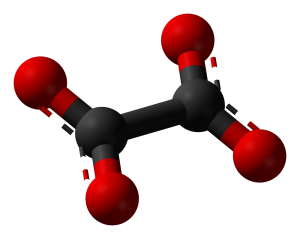Oxalic acid is eliminated by the kidney and is very slightly soluble in urine. Its affinity for calcium of urine resulting in the formation of urinary calcium oxalate stones.

Sample:
24-h urine acidified and stored at 4 ° C for the duration of the collection to prevent crystallization of oxalate (see Samples).
Typical values:
• For women:
<500 micromol / 24 h (45 mg / 24 h)
• In men:
<600 mmol / 24 h (55 mg / 24 h)
Conversion Factors
mg × 11 = ĩmol
ĩmol × 0.09 = mg
Interpretation:
Endogenous or primary hyperoxaluria:
Primary hyperoxaluria type I or oxalosis is a family disease autosomal recessive, very rare but serious due to hepatic deficiency alanine-glyoxylate aminotransferase (AGT).
It manifests in childhood, sometimes as early as the first months of life, a very important hyperoxaluria (> 1200 mmol / 24 h), nephrolithiasis oxalic very strict with nephrocalcinosis that causes kidney failure. When this occurs, the oxaluria decreases and oxalate deposits in many organs (heart, retina, nerves), so the only curative treatment at this stage is the double hepatic and renal transplantation.
Exogenous hyperoxaluria:
Mild hyperoxaluria (<800 mmol / 24 h) may be due to excessive consumption of foods high in oxalate: rhubarb, sorrel, spinach, tomatoes, beets, peppers, asparagus, and especially chocolate.
The enteric hyperoxaluria is due to an increase in the intestinal absorption of oxalate related ileal resection, a short-circuit for treating obesity, Crohn’s disease, etc.
The oxaluria is then of the order of 1000 mmol / 24 h.
Urolithiasis:
Although 60 to 70% of urinary stones are of oxalate stones, hyperoxaluria is rarely a straightforward recognized in urolithiasis in adults. It is possible that some of them are due to mild hyperoxaluria, intermittent (irregular consumption of foods rich in oxalate) unknown.

You must be logged in to post a comment.